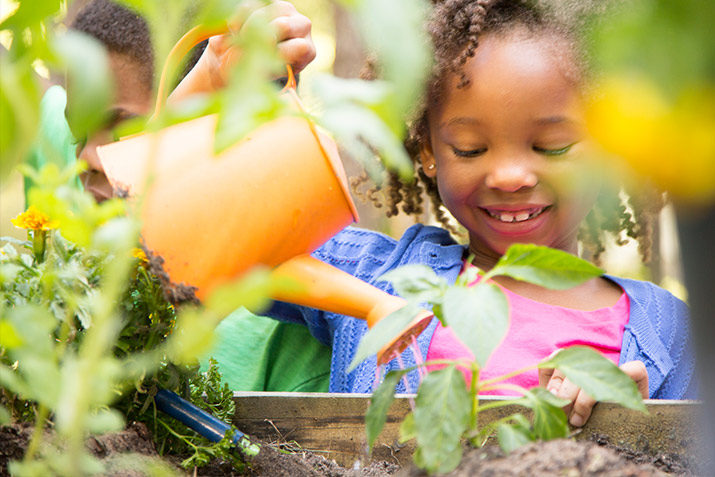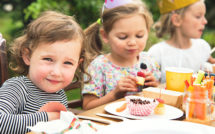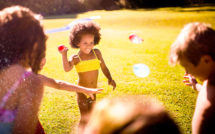
Children are constantly exploring the world around them, and eager to discover as much as possible. Adding science experiments for kids to your preschooler’s at-home activities helps foster a love of science that will serve her well when she starts school. With these seven summer science projects, you might learn something too!
Seed Jar Experiments
Germination occurs when a seed starts to grow, but as seeds are usually underground you rarely see the early part of the process. Seed jars let children see germination as it happens, which is especially cool if they’ve just helped plant seeds in the garden. For germination science experiments for kids, you’ll need:
- A glass jar
- Paper towels
- Water
- Seeds (large seeds like sunflowers, and beans work best)
Have children stuff the glass jar full of paper towels. Add some water to wet the towels, drain off the excess water, and push the wet towels down. You’ll now have room for more towels. Repeat this process until the jar is packed with wet paper towels.
Take the seeds and push them down the inside of the jar so they’re held between the glass and the towels. Now all you have to do is wait for the seed to germinate and kids can watch the seedling develop roots and grow. While you wait, kids can participate in another fun summer activity: coloring! The personalized coloring book Color in the Treehouse lets you color your own plants, trees, and treehouse with a friend or parent!
Tornado in a Bottle
Science projects for kids should be exciting, and what’s more exciting than making your very own tornado? For this project you’ll need:
- A Long narrow bottle with a top (soda bottles work fine)
- Water
- Dish soap
Fill the bottle with water and add a small amount of dish soap. Close the lid tightly and give the bottle a quick twist with your wrist to create a mini tornado. You can use this project to talk about weather and how funnel clouds form.
Worm Farms
Learn about the behavior and biology of worms with this summer science activity! A worm farm shows how worms help move nutrients through the soil—and has that fun gross factor too! You’ll need:
- Large glass jar or container
- Leaves
- Soil
- Package of nightcrawlers from your local bait shop
- Black paper
Fill the glass jar with layers of moist soil interspersed with leaves for the worms to eat. Add the worms and cover the sides of the jar with black paper to encourage the worms to tunnel along the sides. Periodically take off the paper to view the worms and see how they disturb the soil layers. When you’re done, release the worms into your garden.
Plastic Sun Prints
The sun is a popular subject for kid’s science experiments. In this experiment, children learn how the sun’s ultraviolet rays affect objects left in the sunlight. You’ll need:
- Lego or other plastic building toys
- Different colored construction paper
- The sun
Choose a day with clear skies and limited wind for this experiment. Place the Lego blocks on the construction paper and leave the paper out in direct sunlight for a day. By the end of the day, the sun’s ultraviolet rays will have faded the paper not covered by the blocks, and the paper under the blocks will be untouched. Not only are these types of science projects for kids educational, seeing the damage the sun can do may help convince them to use sunscreen!
Rock collecting
Rock collecting may not sound like one of the more exciting science experiments for kids, but it can be lots of fun. Go rock hunting in different areas and learn about the rocks you find. Your child gets to learn about geology and if he’s lucky, he might even find some small fossils.
Learn to Use Binoculars or Microscopes
Binoculars and microscopes make exploring nature more fun. They also open the door for talking to kids about optics and magnification, and how the same principles used by these scientific tools are used to make people’s glasses.
Baking Soda Science
Baking soda is a popular ingredient in many science experiments for kids. While you can conduct baking soda and vinegar experiments indoors, we prefer to leave such experiments for summer, in case your junior chemist decides to see what happens if you add all the vinegar to all the baking soda! You’ll need:
- Baking soda
- Vinegar
- Muffin tin
- Food coloring
- Eyedropper
- Paper towels (for cleanup)
Fill the muffin tins about halfway with baking soda. In small bowls, mix a few drops of food coloring with the vinegar. Use the eyedropper to add the vinegar to the soda. Suggest children experiment with different amounts of baking soda and vinegar mixtures to see which makes the biggest and fizziest reaction. These simple experiments are ideal for introducing children to chemical reactions.
Resources
https://littlebinsforlittlehands.com/spring-science-activities-easy-spring-play-ideas/
https://www.howweelearn.com/seed-germination-kids/
https://littlebinsforlittlehands.com/lego-construction-paper-sun-prints-activity/
https://littlebinsforlittlehands.com/baking-soda-science-fun/


